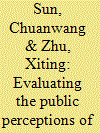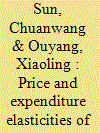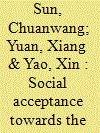|
|
|
Sort Order |
|
|
|
Items / Page
|
|
|
|
|
|
|
| Srl | Item |
| 1 |
ID:
166343


|
|
|
|
|
| Summary/Abstract |
In the global specialization, a Global Value Chain (GVC) has been formed across economies. Countries are trying to improve the position of manufacturing in GVC to alleviate environmental constraints they faced. Based on the panel data of 60 countries in the world from 2000 to 2011, the carbon efficiency and the GVC position index are both evaluated, and the impact of position of manufacturing in GVC on carbon efficiency is further analyzed. Our results show that there is a significant positive correlation between them. Moreover, the impact is associated with the level of economic development, which means that promotion of the GVC embedding degree could optimize energy efficiency and reduce emissions more significantly in developing countries with relatively backward economies than in those developed countries. After further subdividing the manufacturing industry into three types: labor-intensive, resource-intensive and technology-intensive, we find that improving the position of the technology-intensive manufacturing industry in GVC has more significant positive effect on carbon efficiency than the other two types.
|
|
|
|
|
|
|
|
|
|
|
|
|
|
|
|
| 2 |
ID:
193722


|
|
|
|
|
| Summary/Abstract |
Distance can influence the emotional attitudes of media coverage in different countries. To effectively promote climate cooperation between countries, it is crucial to understand the emotional tendencies of carbon-related coverage among different countries and their influencing factors. This study examines whether economic distance affects emotional attitudes towards carbon-related coverage of India across different countries. As a major emitter of carbon, India has attracted attention from various countries, leading to successive reporting on its carbon-related issues. Through sentiment analysis of 3894 English articles from different countries, this paper finds that economic distance has a negative impact on the emotional tendencies of direct reporting on India’s carbon-related issues. This result remains robust under various circumstances. The duration of each country establishing diplomatic relations with India is used as instrumental variables to discuss endogeneity. In addition, heterogeneity analysis indicates that economic distance has a relatively significant impact on the sentiments of media in developed countries, low-emission countries, and Europe. The study further reveals that cultural distance reinforces the negative effect of economic distance on carbon-related coverage of India.
|
|
|
|
|
|
|
|
|
|
|
|
|
|
|
|
| 3 |
ID:
191397


|
|
|
|
|
| Summary/Abstract |
Green finance is important in carbon reduction, but few studies pay attention to Green Credit Policy (GCP). This study examines the relationship between GCP and CO2 emissions of Chinese heavily polluting enterprises (HPEs). Taking the implementation of Green Credit Guidelines (GCG) as a quasi-natural experiment, we design a Difference-in-Difference (DID) model using panel data. The evidence reveals that GCG can indirectly decrease CO2 emissions by increasing financing costs and improving technical efficiency. Further studies find that companies with non-state background, medium-sized companies and companies in eastern regions are more sensitive to the policy. The paper provides policy implications for building a green financial system and supporting endeavors to achieve carbon peak and carbon neutrality.
|
|
|
|
|
|
|
|
|
|
|
|
|
|
|
|
| 4 |
ID:
093535


|
|
|
|
|
| Publication |
2010.
|
| Summary/Abstract |
China is the world's largest emitter of carbon dioxide (CO2). As exports account for about one-third of China's GDP, the CO2 emissions are related to not only China's own consumption but also external demand. Using the input-output analysis (IOA), we analyze the embodied CO2 emissions of China's import and export. Our results show that about 3357 million tons CO2 emissions were embodied in the exports and the emissions avoided by imports (EAI) were 2333 million tons in 2005. The average contribution to embodied emission factors by electricity generation was over 35%. And that by cement production was about 20%. It implies that the production-based emissions of China are more than the consumption-based emissions, which is evidence that carbon leakage occurs under the current climate policies and international trade rules. In addition to the call for a new global framework to allocate emission responsibilities, China should make great efforts to improve its energy efficiency, carry out electricity pricing reforms and increase renewable energy. In particular, to use advanced technology in cement production will be helpful to China's CO2 abatement.
|
|
|
|
|
|
|
|
|
|
|
|
|
|
|
|
| 5 |
ID:
183081


|
|
|
|
|
| Summary/Abstract |
Estimation of the effects of air pollution on residents' subjective welfare, which is always monetized as willingness to pay (WTP), is essential for policymakers to set the optimal abatement targets. This paper adopts Life Satisfaction Approach to explore the mechanism of air pollution affecting residents' subjective well-being (SWB), and calculates the optimal abatement rate. Based on CGSS data, we use the Probit model and the instrumental variables method to conduct empirical analysis. Results show that the positive indirect effect of air pollution through economic growth channel covers nearly 1/3 of the negative direct effect on SWB, which reduces people's willingness to pay for pollution control. Under the maximization of SWB, the optimal reduction rate is 62.857%. To achieve the optimal rate, about 5% of per capita GDP would have to be sacrificed, equivalent to a 20% increase in physical capital stock per capita, or a 13% boost of the human capital stock. When residents have lower education and higher self-rated health, the transmission mechanism amplifies the extent to which the indirect effects mask the direct effects, and the optimal reduction rate drops to 50%.
|
|
|
|
|
|
|
|
|
|
|
|
|
|
|
|
| 6 |
ID:
132674


|
|
|
|
|
| Publication |
2014.
|
| Summary/Abstract |
After the Fukushima nuclear accident, more and more attention has been paid to the safety issues of nuclear power in China, even though it is a clean and necessary substitution to coal power. Due to the consideration about the uncertainty of nuclear safety, the local citizens may resist the nuclear power programs in their neighborhood, as indicated by the anti-nuclear movement in Jiangmen 2013. This phenomenon is often related to the public perceptions of "not-in-my-back-yard" (NIMABY). The explosion of anti-nuclear movements will impose adverse effects on the nuclear power decision-making in China. Based on the Contingent Valuation Method (CVM), we evaluate the public Willingness-To-Pay (WTP) for avoiding the construction of nuclear power plants in their neighborhood. Moreover, we analyze whether more information about nuclear energy could improve the public acceptance. Our results show that the comprehensive information will decrease the public risk perception of nuclear power and increase the public support for nuclear power policy. This paper further suggests that China×s decision makers should improve policy transparency and encourage the public involvement of nuclear energy decision making.
|
|
|
|
|
|
|
|
|
|
|
|
|
|
|
|
| 7 |
ID:
166538


|
|
|
|
|
| Summary/Abstract |
A large number of studies on road construction and rail transit have not taken the improvement effect and the substitution effect into account. Using the quarterly data from 2013 to 2016 of 28 cities with metro opened in China, this research firstly compares the improvement effect of road reconstruction with the substitution effect of rail transit construction on air quality. Empirical results show that urban rail construction exerts a greater marginal impact on improving air quality than urban road reconstruction. Then, we employ operation length of urban rail transit as a long-term proxy variable and the length of rail built in season as a short-term proxy variable of rail transit construction to make a further discussion. In general, rail transit has an air pollution-reducing effect in the long run, while the construction of rail transit has a negative short-term effect on air quality. Based on above findings, governments should take measures to conduct convenient and efficient urban transportation network, and guide the construction of rail transit to multi-level development.
|
|
|
|
|
|
|
|
|
|
|
|
|
|
|
|
| 8 |
ID:
162315


|
|
|
|
|
| Summary/Abstract |
As a newly-proposed method, intermediate approach has several unique features, relative to conventional radial and non-radial approaches. This study contributes to the DEA literature by combining intermediate approach with group heterogeneity in a time horizon. This extended methodology has two important advantages, since it can separate inefficiency related to different production frontiers originated from heterogeneity issue and provide steady results of time effects across periods. Empirically, this method is used to examine unified efficiency of Chinese fossil fuel power plants at provincial levels from 2005 to 2015. All provinces are classified into two regional groups. Our main findings are as follows. First, there exists significant group heterogeneity between coastal and inland provinces, where coastal provinces outperform inland provinces. Second, there are considerable differences in unified efficiency measures across provinces. For most observations, best-practice gap ratio is the most important driving factor. Furthermore, the relative importance of three decomposed indicators varies sharply across provinces. Finally, the concept of managerial disposability should attract sufficient attention, when designing environmental policies. Thus, there should be more combined contributions from eco-technology advancements along with managerial efficiency improvements by corporate leaders and policy makers. This can a new direction for China's environmental policy.
|
|
|
|
|
|
|
|
|
|
|
|
|
|
|
|
| 9 |
ID:
150375


|
|
|
|
|
| Summary/Abstract |
Urbanization, one of the most obvious characteristics of economic growth in China, has an apparent “lock-in effect” on residential energy consumption pattern. It is expected that residential sector would become a major force that drives China's energy consumption after urbanization process. We estimate price and expenditure elasticities of residential energy demand using data from China's Residential Energy Consumption Survey (CRECS) that covers households at different income levels and from different regional and social groups. Empirical results from the Almost Ideal Demand System model are in accordance with the basic expectations: the demands for electricity, natural gas and transport fuels are inelastic in the residential sector due to the unreasonable pricing mechanism. We further investigate the sensitivities of different income groups to prices of the three types of energy. Policy simulations indicate that rationalizing energy pricing mechanism is an important guarantee for energy sustainable development during urbanization. Finally, we put forward suggestions on energy pricing reform in the residential sector based on characteristics of China's undergoing urbanization process and the current energy consumption situations.
|
|
|
|
|
|
|
|
|
|
|
|
|
|
|
|
| 10 |
ID:
124630


|
|
|
|
|
| Publication |
2013.
|
| Summary/Abstract |
The Chinese households that make up approximately a quarter of world households are facing a residential power tariff reform in which a rising block tariff structure will be implemented, and this tariff mechanism is widely used around the world. The basic principle of the structure is to assign a higher price for higher income consumers with low price elasticity of power demand. To capture the non-linear effects of price and income on elasticities, we set up a translog demand model. The empirical findings indicate that the higher income consumers are less sensitive than those with lower income to price changes. We further put forward three proposals of Chinese residential electricity tariffs. Compared to a flat tariff, the reasonable block tariff structure generates more efficient allocation of cross-subsidies, better incentives for raising the efficiency of electricity usage and reducing emissions from power generation, which also supports the living standards of low income households.
|
|
|
|
|
|
|
|
|
|
|
|
|
|
|
|
| 11 |
ID:
150468


|
|
|
|
|
| Summary/Abstract |
Air pollution is one of the most predominant challenges in China. In order to ensure the smog governance projects could be promoted smoothly and the public shoulder the environmental responsibilities consciously, it is necessary for the policymakers to take public attitude into consideration, and understand the public willingness to pay (WTP) for smog mitigation. This paper adopts a CV method framework to assess the value of WTP and analyze the determinants. Given the consideration of the possible presence of the selectivity bias caused by protest responses, the bivariate sample selection model is constructed for estimation. Results show that up to 14% of respondents hold the protest responses, and neglecting the selection bias caused by protest responses would lead to downward biased estimates. The mean value of WTP for the smog mitigation is 1590.36 RMB per year, accounting for about 1% of annual income. Moreover, the NIMBY (not in my backyard) attitude among public is found to be significantly correlated with their WTP, and the other determinants such as household annual income, energy expenditure and economic loss caused by smog could also substantially affect the value of WTP. We further recommend grading governance and policy transparency to address the smog crisis.
|
|
|
|
|
|
|
|
|
|
|
|
|
|
|
|
| 12 |
ID:
169891


|
|
|
|
|
| Summary/Abstract |
To analyze the impact of the increase of public transport on the urban air quality will contribute to the sustainable development of urbanization. But many existing studies have not paid attention to the potential endogeneity of estimation, which comes from the fact that the deterioration of air quality would in turn affect the policies of public transport investment. This paper attempts to control this endogeneity by introducing an instrument variable of the urban built-up area into the empirical models. Using city-level data from China, our study adopts 2SLS method and conducts a series of robustness tests to ensure the estimation results more convincing and robust. The results show that the urban air quality could be improved if the city provides more buses for public transport. Moreover, after controlling the endogeneity, the marginal improving effect of increasing the public transport on urban air quality could be larger from 0.082 to 0.678. This finding indicates that the endogeneity bias is likely to cause the underestimation of the improving effect, and may result in some errors of the policy decisions of urban investment.
|
|
|
|
|
|
|
|
|
|
|
|
|
|
|
|
| 13 |
ID:
183591


|
|
|
|
|
| Summary/Abstract |
Many local governments have taken various regulations to control heavy traffic and alleviate vehicle pollution emissions continuously. In practice, one of the most common and widely used regulations is the motor vehicle restriction policy (MVR policy). But it is unknown whether a motor vehicle restriction policy can effectively alleviate traffic pollution. Moreover, few studies considered the duration of the policy and distinct the effects of different types of MVR policies. In this paper, we first classify the MVR policies into consecutive and intermittent restrictions policies and analyze their different effects on air pollution based on the difference-in-differences method. Further, we take the Mediation Effect Model to verify the conduction mechanism of the impact. The result shows that both consecutive and intermittent policies can improve air quality, while the latter's effect is more significant. Moreover, as for the impact's conduction mechanism, we find that consecutive policies alleviate pollution by changing driving preference and vehicle purchase. Still, the intermittent policies alleviate pollution by promptly easing traffic jams and avoiding unnecessary vehicle emissions of the idling engine. This founding provides a decision-making basis to the government for more efficient and reasonable regulation policies.
|
|
|
|
|
|
|
|
|
|
|
|
|
|
|
|
|
|
|
|
|